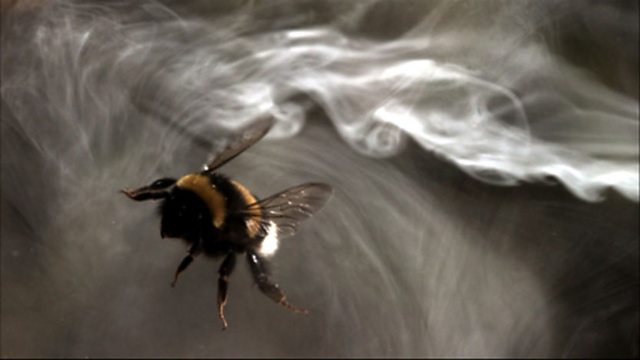
Impossible flight
When a French entomologist declared that it was impossible for bumblebees to fly - when quite clearly they did - it set scientists on a mission to find out how this aerodynamic mystery occurred. Here, super slow motion photography, and some smoke (but no mirrors) illuminates the extraordinary technique that allows these 'blimps' to remain airborne.
The bumblebee is an aerodynamic mystery that had scientists baffled for years. A large round body, supported only by tiny wings - in theory these creatures shouldn't get off the ground. The confusion started over 70 years ago when a French entomologist calculated that bee flight was aerodynamically impossible. Ever since then scientists have struggled to understand just how a bees seemingly random flapping could possibly keep it airborne. At first, even seen in slow motion the mystery doesn't get any clearer. The only way bumblebees stay in the air is by furiously flapping their wings in an extraodinary 200 beats every second. That's why bees are so round - the chest is a mass of muscle to power the wings. As the bee beats its wings, air is pulled downwards. Richard Hammond releases some smoke to illustrate the effect. This generates lift but not enough to keep the bee airborne. Only in super slo-mo can we see exactly how it works. At the end of each downbeat, the bee twists its wings over, so even on the upstroke the air is still pulled downwards, giving them double the amount of lift. And that's not something seen on any aeroplane!
Duration:
This clip is from
Featured in...
![]()
High Speed - Life slowed down
A collection of clips showing the best in slow motion nature films.
![]()
91热爆 Nature
Be captivated, informed and inspired by the world's wildlife.
![]()
Bees are brilliant
A collection of clips illustrating the importance of the honey bee and its recent decline.
More clips from Speed Limits
-
![]()
Hands on flying
Duration: 00:59
-
![]()
Swimming star
Duration: 03:07
-
![]()
Use the force
Duration: 02:26
-
![]()
Extreme speeds
Duration: 01:58
More clips from Richard Hammond's Invisible Worlds
-
![]()
Hands on flying—Speed Limits
Duration: 00:59
-
![]()
Swimming star—Speed Limits
Duration: 03:07
-
![]()
Use the force—Speed Limits
Duration: 02:26
-
![]()
Extreme speeds—Speed Limits
Duration: 01:58






